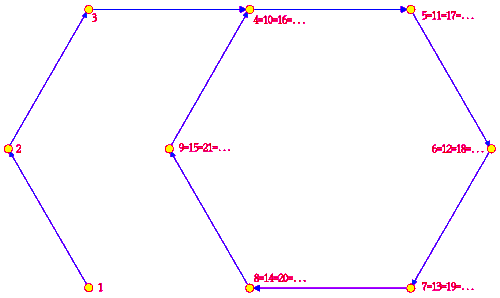In mathematics, a monogenic semigroup is a semigroup generated by a single element.[1] Monogenic semigroups are also called cyclic semigroups.[2]

Structure
editThe monogenic semigroup generated by the singleton set {a} is denoted by . The set of elements of is {a, a2, a3, ...}. There are two possibilities for the monogenic semigroup :
- am = an ⇒ m = n.
- There exist m ≠ n such that am = an.
In the former case is isomorphic to the semigroup ({1, 2, ...}, +) of natural numbers under addition. In such a case, is an infinite monogenic semigroup and the element a is said to have infinite order. It is sometimes called the free monogenic semigroup because it is also a free semigroup with one generator.
In the latter case let m be the smallest positive integer such that am = ax for some positive integer x ≠ m, and let r be smallest positive integer such that am = am+r. The positive integer m is referred to as the index and the positive integer r as the period of the monogenic semigroup . The order of a is defined as m+r−1. The period and the index satisfy the following properties:
- am = am+r
- am+x = am+y if and only if m + x ≡ m + y (mod r)
- = {a, a2, ... , am+r−1}
- Ka = {am, am+1, ... , am+r−1} is a cyclic subgroup and also an ideal of . It is called the kernel of a and it is the minimal ideal of the monogenic semigroup .[3][4]
The pair (m, r) of positive integers determine the structure of monogenic semigroups. For every pair (m, r) of positive integers, there exists a monogenic semigroup having index m and period r. The monogenic semigroup having index m and period r is denoted by M(m, r). The monogenic semigroup M(1, r) is the cyclic group of order r.
The results in this section actually hold for any element a of an arbitrary semigroup and the monogenic subsemigroup it generates.
Related notions
editA related notion is that of periodic semigroup (also called torsion semigroup), in which every element has finite order (or, equivalently, in which every monogenic subsemigroup is finite). A more general class is that of quasi-periodic semigroups (aka group-bound semigroups or epigroups) in which every element of the semigroup has a power that lies in a subgroup.[5][6]
An aperiodic semigroup is one in which every monogenic subsemigroup has a period of 1.
See also
edit- Cycle detection, the problem of finding the parameters of a finite monogenic semigroup using a bounded amount of storage space
- Special classes of semigroups
References
edit- ^ Howie, J M (1976). An Introduction to Semigroup Theory. L.M.S. Monographs. Vol. 7. Academic Press. pp. 7–11. ISBN 0-12-356950-8.
- ^ A H Clifford; G B Preston (1961). The Algebraic Theory of Semigroups Vol.I. Mathematical Surveys. Vol. 7. American Mathematical Society. pp. 19–20. ISBN 978-0821802724.
- ^ "Kernel of a semi-group - Encyclopedia of Mathematics".
- ^ "Minimal ideal - Encyclopedia of Mathematics".
- ^ "Periodic semi-group - Encyclopedia of Mathematics".
- ^ Peter M. Higgins (1992). Techniques of semigroup theory. Oxford University Press. p. 4. ISBN 978-0-19-853577-5.